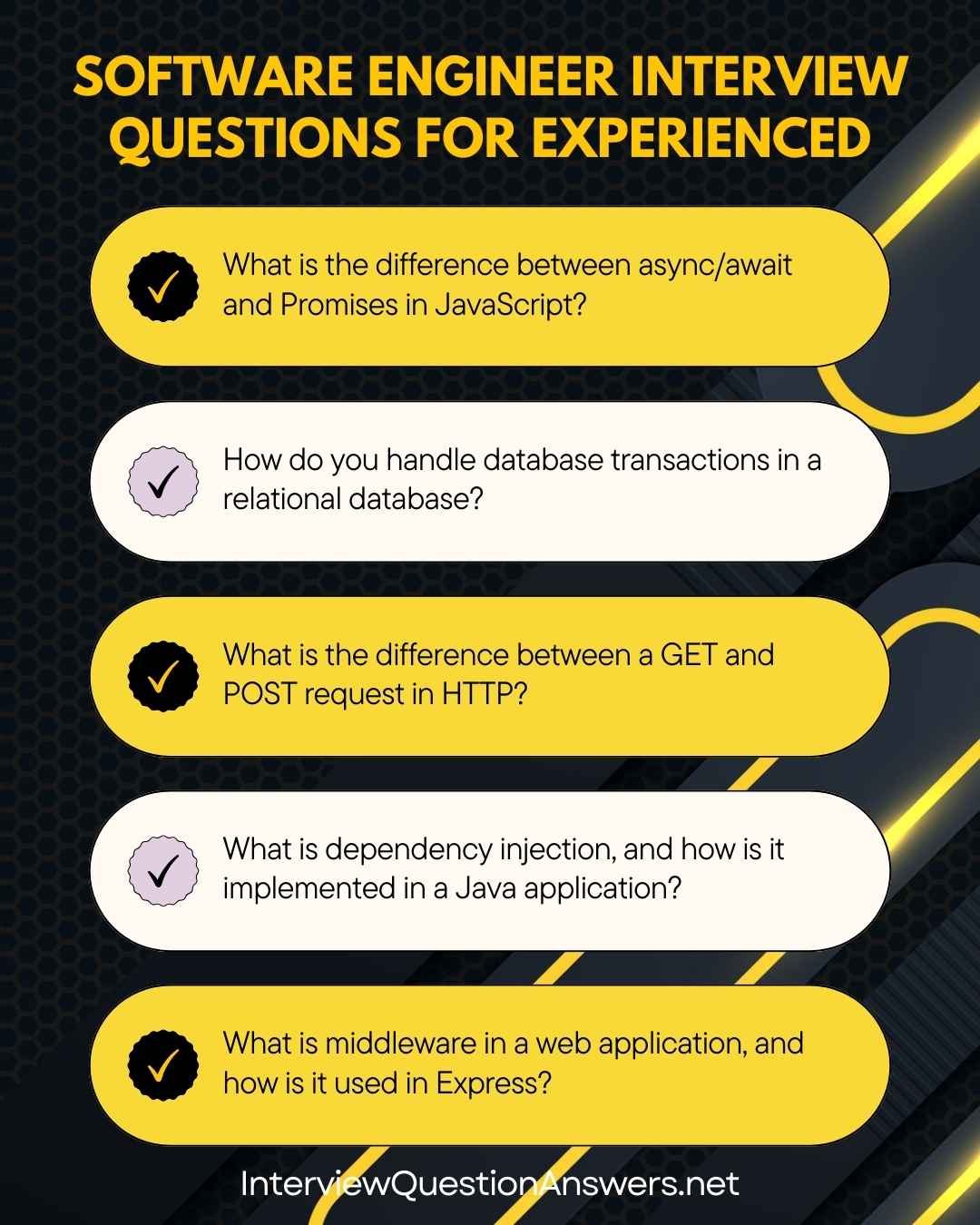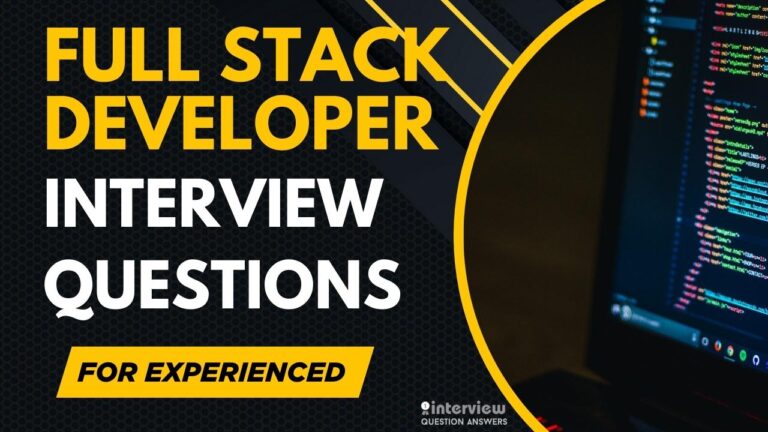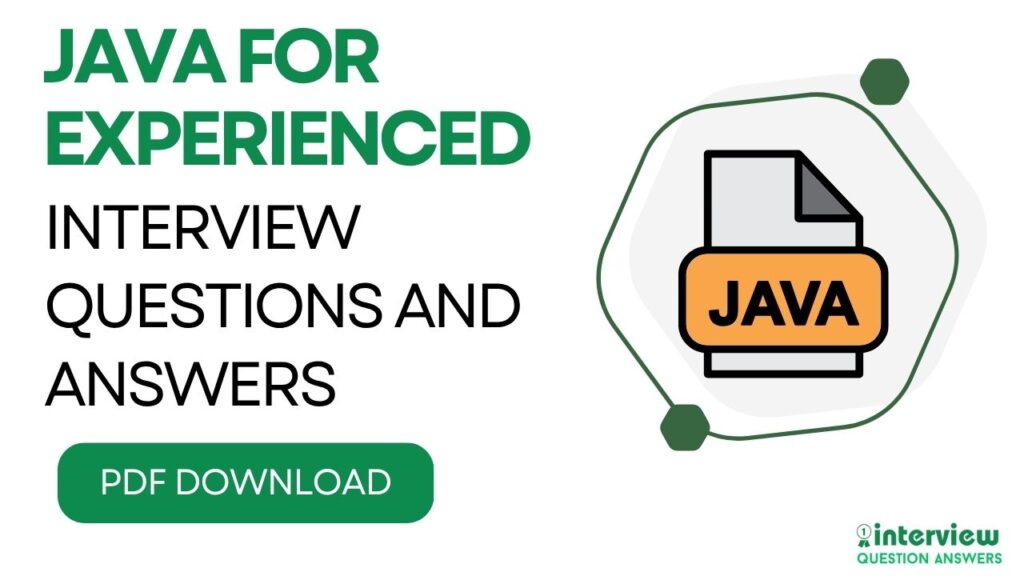Top Software Engineer Interview Questions for Experienced
Software Engineer Interview Questions for Experienced professionals cover challenging technical problems, system design decisions, and leadership skills that companies look for in senior developers. Getting promoted to senior software engineering positions means you need to show your ability to build large-scale systems and guide other developers effectively.
This complete guide provides Software Engineer Interview Questions for Experienced engineers who have worked on real production applications, including topics like distributed systems, software architecture patterns, code quality standards, and team coordination responsibilities.
These Software Engineer Interview Questions for Experienced engineers will help you demonstrate your technical expertise, show examples of successful project deliveries, and prove you’re ready for senior-level responsibilities in modern software development teams.
Table of Contents
Software Engineer Interview Questions for 2 Years Experience
Que 1. How do you optimize a web application’s frontend performance?
Answer:
Optimize by minifying CSS/JS, using lazy loading for images, and leveraging browser caching. Implement code splitting with tools like Webpack, reduce DOM operations, and use CDNs for static assets. Profile with Chrome DevTools to identify bottlenecks and optimize critical rendering paths.
Que 2. What is the difference between async/await and Promises in JavaScript?
Answer:async/await is syntactic sugar over Promises, offering cleaner asynchronous code. Promises use .then() and .catch(), while async/await allows sequential-style code with error handling via try-catch. Both handle asynchronous tasks, but async/await improves readability.
async function fetchData() {
try {
const res = await fetch('https://api.example.com/data');
return res.json();
} catch (err) {
console.error(err);
}
}Que 3. How do you implement a RESTful API in Node.js using Express?
Answer:
Use Express to define routes for CRUD operations, handle HTTP methods, and return JSON responses. Implement middleware for validation and error handling.
const express = require('express');
const app = express();
app.use(express.json());
app.get('/api/users', (req, res) => res.json([{ id: 1, name: 'John' }]));
app.listen(3000, () => console.log('Server running'));Que 4. How do you handle database transactions in a relational database?
Answer:
Use transactions to ensure data consistency with BEGIN, COMMIT, and ROLLBACK. In SQL, wrap operations in a transaction block; in ORMs like SQLAlchemy, use session management.
# SQLAlchemy example
from sqlalchemy import create_engine, text
engine = create_engine('sqlite:///example.db')
with engine.connect() as conn:
conn.execute(text('BEGIN'))
try:
conn.execute(text('INSERT INTO users (name) VALUES (:name)'), {'name': 'John'})
conn.execute(text('COMMIT'))
except:
conn.execute(text('ROLLBACK'))Que 5. What is the difference between a GET and POST request in HTTP?
Answer:
GET retrieves data, is idempotent, and sends parameters in the URL. POST submits data, is non-idempotent, and sends data in the request body. GET is visible in browser history, while POST is more secure for sensitive data.
Que 6. How do you implement unit testing in a Python application?
Answer:
Use unittest or pytest to write test cases, mocking dependencies with unittest.mock. Test functions or classes, assert expected outcomes, and automate via CI/CD.
import unittest
def add(a, b):
return a + b
class TestMath(unittest.TestCase):
def test_add(self):
self.assertEqual(add(2, 3), 5)
if __name__ == '__main__':
unittest.main()Que 7. What is a race condition, and how do you prevent it?
Answer:
A race condition occurs when multiple threads access shared resources concurrently, causing unpredictable results. Prevent it with locks (e.g., threading.Lock in Python), atomic operations, or thread-safe data structures.
import threading
lock = threading.Lock()
counter = 0
def increment():
global counter
with lock:
counter += 1Que 8. How do you sort an array of objects by a specific property in JavaScript?
Answer:
Use the Array.sort() method with a comparison function based on the desired property.
const users = [{ name: 'Bob', age: 30 }, { name: 'Alice', age: 25 }];
users.sort((a, b) => a.age - b.age); // Sorts by ageQue 9. What is dependency injection, and how is it implemented in a Java application?
Answer:
Dependency injection provides dependencies externally, improving modularity. In Java, use frameworks like Spring to inject dependencies via constructor or setter injection.
public class Service {
private final Database db;
public Service(Database db) { // Constructor injection
this.db = db;
}
}Que 10. How do you handle CORS issues in a web application?
Answer:
Enable CORS on the server with headers like Access-Control-Allow-Origin. In Express, use the cors middleware or configure specific origins.
const express = require('express');
const cors = require('cors');
const app = express();
app.use(cors({ origin: 'http://example.com' }));Software Engineer Interview Questions for 3 Years Experience
Que 11. What is the difference between a shallow copy and a deep copy in Python?
Answer:
A shallow copy duplicates the top-level structure but shares nested objects (copy.copy()). A deep copy duplicates all levels (copy.deepcopy()), creating independent copies.
import copy
lst = [[1, 2], 3]
shallow = copy.copy(lst)
deep = copy.deepcopy(lst)Que 12. How do you implement a binary tree traversal in Python?
Answer:
Implement traversals (inorder, preorder, postorder) using recursion or iteration. Inorder (left-root-right) example:
class Node:
def __init__(self, value):
self.value = value
self.left = self.right = None
def inorder(root):
if root:
inorder(root.left)
print(root.value, end=' ')
inorder(root.right)Que 13. What is middleware in a web application, and how is it used in Express?
Answer:
Middleware functions process requests in a pipeline, handling tasks like logging or authentication. In Express, middleware is applied with app.use().
const express = require('express');
const app = express();
app.use((req, res, next) => {
console.log('Request received');
next();
});Que 14. How do you optimize a SQL query for large datasets?
Answer:
Add indexes on queried columns, avoid SELECT *, and use specific columns. Use query execution plans to identify bottlenecks, limit joins, and leverage pagination with LIMIT and OFFSET.
CREATE INDEX idx_name ON users(name);
SELECT name FROM users WHERE age > 18 LIMIT 10;
Que 15. What is a closure in Python, and how is it used?
Answer:
A closure is a nested function that retains access to its outer function’s variables after the outer function executes. Useful for data encapsulation.
def outer(name):
def inner():
return f"Hello, {name}"
return inner
greeting = outer("Alice")
print(greeting()) # Outputs: Hello, AliceQue 16. How do you handle file uploads in a Node.js application?
Answer:
Use multer middleware in Express to handle file uploads, configuring storage and limits. Save files to disk or cloud storage like AWS S3.
const multer = require('multer');
const upload = multer({ dest: 'uploads/' });
app.post('/upload', upload.single('file'), (req, res) => {
res.send('File uploaded');
});Que 17. What is the difference between map(), filter(), and reduce() in JavaScript?
Answer:map() transforms each element, filter() selects elements based on a condition, and reduce() aggregates elements into a single value.
const arr = [1, 2, 3];
const mapped = arr.map(x => x * 2); // [2, 4, 6]
const filtered = arr.filter(x => x > 1); // [2, 3]
const reduced = arr.reduce((sum, x) => sum + x, 0); // 6Que 18. How do you implement a stack data structure in Python?
Answer:
Use a list as a stack with append() for push and pop() for pop, following LIFO (Last-In-First-Out).
class Stack:
def __init__(self):
self.items = []
def push(self, item):
self.items.append(item)
def pop(self):
return self.items.pop() if self.items else NoneQue 19. What is the purpose of Docker in software development?
Answer:
Docker containers package applications with dependencies, ensuring consistent environments across development, testing, and production. Use Dockerfiles to define images and docker-compose for multi-container apps.
FROM node:16
WORKDIR /app
COPY . .
RUN npm install
CMD ["npm", "start"]Que 20. How do you secure a REST API in a web application?
Answer:
Use JWT or OAuth for authentication, HTTPS for encryption, and rate limiting to prevent abuse. Validate inputs, implement role-based access control, and log requests with tools like Winston.
const jwt = require('jsonwebtoken');
function authenticate(req, res, next) {
const token = req.header('Authorization');
if (!token) return res.status(401).send('Unauthorized');
jwt.verify(token, 'secret', (err, user) => {
if (err) return res.status(403).send('Invalid token');
req.user = user;
next();
});
}
Also Check: Software Engineer Interview Questions for Freshers
Software Engineer Interview Questions for 5 Years Experience
Que 21. How do you design a scalable REST API for high traffic?
Answer:
Design with stateless endpoints, use load balancers (e.g., AWS ELB), and implement caching with Redis or Memcached. Use rate limiting, optimize database queries with indexing, and scale horizontally with microservices on Kubernetes. Monitor with Prometheus and Grafana for performance insights.
const express = require('express');
const app = express();
app.get('/api/data', async (req, res) => {
const cached = await redis.get('data');
if (cached) return res.json(JSON.parse(cached));
const data = await db.query('SELECT * FROM data');
await redis.set('data', JSON.stringify(data), 'EX', 3600);
res.json(data);
});Que 22. How do you handle database schema migrations in a production environment?
Answer:
Use tools like Flyway or Liquibase for automated migrations. Apply incremental changes, test in staging, and use zero-downtime deployment strategies (e.g., blue-green). Backup data before migrations and maintain rollback scripts for recovery.
# Flyway migration script (V1__create_table.sql)
CREATE TABLE users (
id INT PRIMARY KEY,
name VARCHAR(255)
);Que 23. What is the Circuit Breaker pattern, and how do you implement it?
Answer:
The Circuit Breaker pattern prevents cascading failures in distributed systems by halting requests to a failing service. Implement with libraries like Resilience4j (Java) or node-circuitbreaker. Monitor failures and open/close the circuit based on thresholds.
import io.github.resilience4j.circuitbreaker.CircuitBreaker;
CircuitBreaker circuitBreaker = CircuitBreaker.ofDefaults("api");
String result = circuitBreaker.executeSupplier(() -> callApi());Que 24. How do you implement authentication and authorization in a microservices architecture?
Answer:
Use OAuth 2.0 or JWT for authentication, with a centralized identity provider (e.g., Keycloak). Implement authorization with role-based access control (RBAC) at the API Gateway (e.g., Kong). Validate tokens in each microservice and use scopes for fine-grained access.
const jwt = require('jsonwebtoken');
function authMiddleware(req, res, next) {
const token = req.header('Authorization').replace('Bearer ', '');
jwt.verify(token, process.env.JWT_SECRET, (err, user) => {
if (err) return res.status(401).send('Unauthorized');
req.user = user;
next();
});
}Que 25. How do you optimize a Node.js application for high concurrency?
Answer:
Use the cluster module to leverage multiple CPU cores, implement async I/O with async/await, and offload heavy tasks to worker threads or queues (e.g., Bull). Optimize database queries and use PM2 for process management and load balancing.
const cluster = require('cluster');
if (cluster.isMaster) {
for (let i = 0; i < require('os').cpus().length; i++) {
cluster.fork();
}
} else {
const express = require('express');
const app = express();
app.get('/', (req, res) => res.send('Hello'));
app.listen(3000);
}Que 26. What is eventual consistency, and how do you handle it in distributed systems?
Answer:
Eventual consistency ensures data converges to the same state across nodes over time, common in NoSQL databases like DynamoDB. Handle with event-driven architectures (e.g., Kafka), implementing retry mechanisms and conflict resolution (e.g., CRDTs or versioning).
Que 27. How do you implement a message queue system for asynchronous task processing?
Answer:
Use RabbitMQ or AWS SQS for message queues. Publish tasks to queues and process with consumers, ensuring fault tolerance with retries and dead-letter queues. Monitor with tools like CloudWatch.
import pika
connection = pika.BlockingConnection(pika.ConnectionParameters('localhost'))
channel = connection.channel()
channel.queue_declare(queue='tasks')
channel.basic_publish(exchange='', routing_key='tasks', body='Task data')
connection.close()Que 28. How do you secure sensitive data in a software application?
Answer:
Encrypt sensitive data with AES (e.g., crypto in Node.js), store secrets in environment variables or vaults (e.g., AWS Secrets Manager), and use HTTPS for data in transit. Implement least-privilege access and audit logs for security monitoring.
const crypto = require('crypto');
const cipher = crypto.createCipher('aes-256-cbc', 'secret-key');
let encrypted = cipher.update('data', 'utf8', 'hex');
encrypted += cipher.final('hex');Que 29. How do you implement logging in a distributed application?
Answer:
Use centralized logging with tools like ELK Stack or Loki. Implement structured logging with libraries like Winston (Node.js) or Log4j (Java). Correlate logs with request IDs and monitor with dashboards for real-time insights.
const winston = require('winston');
const logger = winston.createLogger({
transports: [new winston.transports.File({ filename: 'app.log' })]
});
logger.info('Application started', { requestId: '123' });Que 30. How do you design a system to handle large-scale file uploads?
Answer:
Use chunked uploads with presigned URLs (e.g., AWS S3) to handle large files. Implement resumable uploads, validate file types, and use a queue (e.g., SQS) for processing. Monitor upload progress and store metadata in a database.
const AWS = require('aws-sdk');
const s3 = new AWS.S3();
app.post('/upload', async (req, res) => {
const params = { Bucket: 'my-bucket', Key: req.file.name, Body: req.file };
await s3.upload(params).promise();
res.send('Uploaded');
});Software Engineer Interview Questions for 7 Years Experience
Que 31. How do you optimize a Java application for low-latency responses?
Answer:
Tune JVM settings (e.g., garbage collection, heap size), use efficient data structures, and minimize I/O operations. Implement caching with Caffeine, use asynchronous processing with CompletableFuture, and profile with VisualVM to identify bottlenecks.
CompletableFuture.supplyAsync(() -> fetchData())
.thenAccept(data -> process(data));Que 32. What is the Saga pattern, and how do you implement it in a microservices system?
Answer:
The Saga pattern manages distributed transactions with a series of local transactions, coordinated via events. Implement with event-driven frameworks (e.g., Spring Cloud Stream, Axon). Each service handles its transaction and emits events, with compensating actions for failures.
// Spring Cloud Stream example
@StreamListener("input")
public void handleEvent(OrderEvent event) {
// Process local transaction
emitNextEvent(event);
}Que 33. How do you handle database deadlocks in a relational database?
Answer:
Detect deadlocks with database logs (e.g., MySQL InnoDB status). Prevent by ordering resource access, using shorter transactions, and implementing retry logic. Optimize queries to reduce lock contention and use appropriate isolation levels.
SET TRANSACTION ISOLATION LEVEL READ COMMITTED;
START TRANSACTION;
-- Query logic
COMMIT;Que 34. How do you implement a rate limiter in a Python Flask application?
Answer:
Use flask-limiter with Redis to track request counts per user/IP. Configure limits (e.g., 100 requests/hour) and handle exceeded limits with custom responses.
from flask import Flask
from flask_limiter import Limiter
app = Flask(__name__)
limiter = Limiter(app, default_limits=["100 per hour"])
@app.route('/api')
@limiter.limit("10 per minute")
def api():
return {"message": "Hello"}Que 35. How do you design a fault-tolerant system for a cloud-based application?
Answer:
Use redundancy across regions, implement circuit breakers (e.g., Resilience4j), and retry failed requests. Deploy with Kubernetes for auto-scaling, monitor with Prometheus, and use chaos engineering (e.g., Chaos Monkey) to test resilience.
Que 36. How do you integrate a CI/CD pipeline for a software project?
Answer:
Use tools like Jenkins, GitHub Actions, or GitLab CI. Define pipelines with stages for build, test, and deploy. Automate testing with Jest or pytest, lint with ESLint, and deploy to cloud platforms like AWS ECS or Azure App Service.
# GitHub Actions example
name: CI/CD
on: [push]
jobs:
build:
runs-on: ubuntu-latest
steps:
- uses: actions/checkout@v3
- run: npm install
- run: npm testQue 37. What is the difference between horizontal and vertical scaling?
Answer:
Horizontal scaling adds more servers (e.g., adding EC2 instances), improving throughput for distributed systems. Vertical scaling increases a server’s resources (e.g., CPU, RAM), limited by hardware but simpler to implement.
Que 38. How do you implement observability in a microservices architecture?
Answer:
Implement distributed tracing with Zipkin or Jaeger, metrics with Prometheus, and logging with ELK Stack. Use correlation IDs for request tracking, set up dashboards in Grafana, and configure alerts for proactive monitoring.
const express = require('express');
const app = express();
app.use((req, res, next) => {
req.correlationId = crypto.randomUUID();
logger.info('Request', { correlationId: req.correlationId });
next();
});Que 39. How do you optimize a Python application for memory efficiency?
Answer:
Use generators for large datasets, choose efficient data structures (e.g., sets over lists for lookups), and avoid unnecessary copies. Profile with memory_profiler, use slots in classes, and leverage numpy for large arrays.
# Generator example
def read_large_file():
with open('file.txt') as f:
for line in f:
yield lineQue 40. How do you handle cross-site request forgery (CSRF) in a web application?
Answer:
Use CSRF tokens in forms, validated on the server. In Express, use csurf middleware; in Django, include {% csrf_token %}. Ensure tokens are unique per session and verify with HMAC for security.
const csurf = require('csurf');
app.use(csurf());
app.post('/form', (req, res) => {
res.send('Form submitted');
});Software Engineer Interview Questions for 10 Years Experience
Que 41. How do you design a distributed system to handle millions of requests per second?
Answer:
Design with microservices deployed on Kubernetes for scalability, using load balancers (e.g., AWS ALB) to distribute traffic. Implement caching with Redis, use asynchronous messaging with Kafka, and optimize databases with sharding or read replicas. Monitor with Prometheus and Grafana, and use chaos engineering to ensure resilience.
# Kubernetes deployment example
apiVersion: apps/v1
kind: Deployment
metadata:
name: api-service
spec:
replicas: 10
selector:
matchLabels:
app: api
template:
metadata:
labels:
app: api
spec:
containers:
- name: api
image: my-api:latestQue 42. How do you ensure zero-downtime deployments in a production environment?
Answer:
Use blue-green deployments or canary releases with Kubernetes or AWS ECS. Implement health checks, roll back on failures, and use feature flags to toggle features. Automate with CI/CD pipelines (e.g., Jenkins, ArgoCD) and monitor with tools like Datadog for real-time validation.
# ArgoCD example for canary deployment
apiVersion: argoproj.io/v1alpha1
kind: Rollout
spec:
strategy:
canary:
steps:
- setWeight: 20
- pause: {duration: 10m}Que 43. How do you architect a system to handle real-time data processing at scale?
Answer:
Use Apache Kafka or AWS Kinesis for streaming data, process with Apache Spark or Flink, and store in a scalable database like Cassandra. Implement fault tolerance with retries and dead-letter queues, and monitor with Prometheus. Optimize throughput with partitioning and consumer groups.
# Kafka consumer example
from kafka import KafkaConsumer
consumer = KafkaConsumer('topic', bootstrap_servers='localhost:9092')
for message in consumer:
process(message.value)Que 44. How do you mitigate security risks in a cloud-native application?
Answer:
Implement least-privilege IAM roles, encrypt data with KMS or Vault, and use WAF (e.g., AWS WAF) for threat protection. Enable network security with VPCs, audit with CloudTrail, and scan for vulnerabilities with tools like Snyk. Enforce compliance with automated policies.
// AWS SDK for encrypted S3 upload
const AWS = require('aws-sdk');
const s3 = new AWS.S3({ serverSideEncryption: 'aws:kms', kmsKeyId: 'key-id' });
s3.upload({ Bucket: 'my-bucket', Key: 'file', Body: data });Que 45. How do you optimize a monolithic application before migrating to microservices?
Answer:
Refactor to modularize code, extract services incrementally, and optimize database queries. Implement domain-driven design to identify boundaries, use API gateways for routing, and containerize with Docker. Test migrations in staging and monitor performance impacts.
// Spring Boot modular example
@Service
public class UserService {
private final UserRepository repo;
public UserService(UserRepository repo) {
this.repo = repo;
}
}Que 46. How do you implement observability across a distributed system?
Answer:
Use distributed tracing with Jaeger or Zipkin, metrics with Prometheus, and centralized logging with ELK Stack or Fluentd. Implement correlation IDs for request tracking, set up Grafana dashboards, and configure alerts for proactive monitoring.
// Express middleware for correlation ID
const { v4: uuidv4 } = require('uuid');
app.use((req, res, next) => {
req.correlationId = uuidv4();
logger.info('Request', { correlationId: req.correlationId });
next();
});Que 47. How do you design a system for eventual consistency in a NoSQL database?
Answer:
Use event sourcing with Kafka or EventBridge to propagate changes, implement idempotent operations, and handle conflicts with versioning or CRDTs. Monitor consistency with read-after-write checks and use DynamoDB streams for real-time updates.
# DynamoDB stream handler
def handle_stream(event, context):
for record in event['Records']:
process(record['dynamodb']['NewImage'])Que 48. How do you handle performance bottlenecks in a high-latency microservices system?
Answer:
Profile with tools like New Relic, optimize slow API calls with caching (e.g., Redis), and reduce inter-service latency with gRPC or async messaging. Shard databases, batch requests, and use circuit breakers to handle failures gracefully.
// Resilience4j circuit breaker
CircuitBreaker circuitBreaker = CircuitBreaker.ofDefaults("service");
String result = circuitBreaker.executeSupplier(() -> callService());Que 49. How do you implement a secure CI/CD pipeline for a cloud-based application?
Answer:
Use GitHub Actions or Jenkins with secrets stored in AWS Secrets Manager or HashiCorp Vault. Enforce branch protection, scan code with SonarQube, and deploy with IaC (e.g., Terraform). Automate tests, use signed commits, and monitor pipeline logs for security.
# GitHub Actions with secrets
name: Deploy
jobs:
deploy:
runs-on: ubuntu-latest
steps:
- uses: actions/checkout@v3
- run: aws s3 sync . s3://my-bucket --region us-east-1
env:
AWS_ACCESS_KEY_ID: ${{ secrets.AWS_ACCESS_KEY_ID }}Que 50. How do you architect a system to support multi-region deployment for global availability?
Answer:
Deploy across multiple regions with AWS Global Accelerator or Azure Traffic Manager for low-latency routing. Replicate data with DynamoDB Global Tables or Cosmos DB, use CDNs for static assets, and implement failover with health checks. Monitor with CloudWatch for region-specific performance.
# Terraform for multi-region
resource "aws_dynamodb_table" "global_table" {
name = "my-table"
billing_mode = "PAY_PER_REQUEST"
stream_enabled = true
stream_view_type = "NEW_AND_OLD_IMAGES"
replica {
region_name = "us-west-2"
}
}Conclusion
We’ve covered all the important questions in our Software Engineer Interview Questions for Experienced professionals guide above. This comprehensive resource includes interview questions for senior developers, covering difficult technical problems and leadership situations that employers test during interviews. The software engineering field keeps changing quickly with Docker containers, AI tools, and modern deployment practices becoming must-have skills for experienced roles.
These Software Engineer Interview Questions for Experienced professionals give you everything you need to prepare for your next career move, from complex coding challenges to system architecture discussions. By practicing with these Software Engineer Interview Questions for Experienced and staying updated with new technologies, you’ll have what it takes to land senior software engineering jobs.
Similar Interview Guides:













